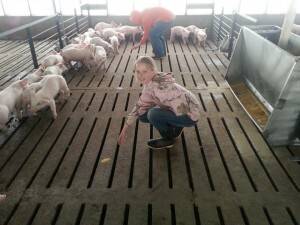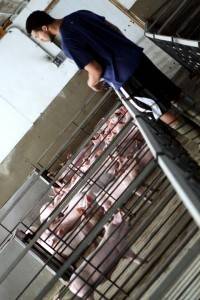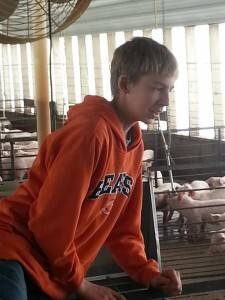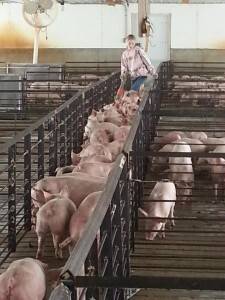Fear of the unknown is always a powerful motivator. Unfortunately, some anti-farm groups and other activists have worked overtime recently to put North Iowans into a tizzy to stop a pork processing plant from being built in our region. Many half-truths and misconceptions were shared online by these folks, so today I’m going to give you my scoop on pig poop!
One of the naysayers’ biggest objections was that “factory farms” would build more big barns to supply the packing plant with pigs. Of course, more pigs mean more pig poop! The naysayers made it sound like pig farms would be polluting the countryside, and I’ll explain the value of “organic nutrients” in a bit. First, I want to address the degrading term “factory farm.” Ironically, the 98% of farm corporations are family farms. “Farm corporation” is really a business structure. In most cases, family members are the so-called stock holders. Wanda Patsche, who blogs at Minnesota Farm Living, does a great job of explaining the “Top 5 Myths of Farm Corporations.”
Now back to pig poop… I’ve mentioned before that I’ve been farming for 60 years. Through the years, farming practices have changed dramatically. When I was younger and my family raised pigs on pasture, we didn’t need to spread any manure. The pigs simply went where they went, but it was a poor way of distributing the “fertilizer.” These organic nutrients definitely weren’t spread evenly across the pasture. (Side note: Poop was commonly used as fertilizer back then because (1) it was readily available. Nearly every farmer raised both crops and livestock; (2) it was free, and everyone was conscientious about making the most of their resources; and (3) commercial fertilizer wasn’t available like it is today.)
Over time, we changed how we raised pigs. We moved them to the farm yard so we could better control what they ate. I remember hoping for a big rain shower on Fridays, so Mother Nature would clean the feeding lots and save me from using a scoop shovel on Saturday. At that time, we didn’t fully appreciate the value of placing this manure on the field to fertilize the crop. We also didn’t understand that the runoff from these feedlots was eventually running into the creek across the road from our farm buildings.
 We learned that lesson, so we changed our practices. We also learned the importance of evenly distributing nutrients across all fields. Back in the “good ol’ days,” we saved time and labor by spreading the manure on the fields closest to our pig lots. The fields farthest from the pigs always were the least fertile as a result. We also didn’t factor in the volatility of nitrogen in the fertilizer. Frankly, we didn’t know that nitrogen migrated in water underground. We’ve learned so much about the movement of nutrients through the soil and water.
We learned that lesson, so we changed our practices. We also learned the importance of evenly distributing nutrients across all fields. Back in the “good ol’ days,” we saved time and labor by spreading the manure on the fields closest to our pig lots. The fields farthest from the pigs always were the least fertile as a result. We also didn’t factor in the volatility of nitrogen in the fertilizer. Frankly, we didn’t know that nitrogen migrated in water underground. We’ve learned so much about the movement of nutrients through the soil and water.
Today we are very careful how we use fertilizer! Livestock producers are required to file with the State of Iowa a manure management plan, or a poop plan to manage the fertilizer produced by our pigs. While this regulation has many downsides, I’ll focus on the good that has come from it. Today’s livestock farmers are taking an intentional approach to placing very valuable fertilizer, a.k.a. poop, where it may be used by the plants grown for crops. We must soil test and analyze our soils to understand how much poop they need to grow our crops.
 Pig farmers are required to test the pig poop to know how much nutritional value is available to the crops. Then we calculate to determine the right amount of poop to spread on each acre to enhance soil productivity and crop yields. There is a whole lot of science and technology that goes in to using pig poop as fertilizer today! We can use GPS technology to provide the exact amount of plant food for every stalk of corn. Talk about a stark contrast to the days when I would slop the pigs with my Grandpa Jensen! Using a little pail, I’d feed the pigs whey from the Coulter creamery.
Pig farmers are required to test the pig poop to know how much nutritional value is available to the crops. Then we calculate to determine the right amount of poop to spread on each acre to enhance soil productivity and crop yields. There is a whole lot of science and technology that goes in to using pig poop as fertilizer today! We can use GPS technology to provide the exact amount of plant food for every stalk of corn. Talk about a stark contrast to the days when I would slop the pigs with my Grandpa Jensen! Using a little pail, I’d feed the pigs whey from the Coulter creamery.
Today’s pig farmers are doing their best to take care of our resources. Not only do we precisely measure where the poop is placed on a farm field, but the way we store our pig poop also is studied and regulated. Pig manure must be stored in an enclosed tank, so none of the nutrient value is lost. Then the pig poop is taken directly to the field by tank or via an “umbilical cord,” which is a long hose that connects the storage tank to a tillage tool that puts the poop directly in to the soil where crops grow. While inserting manure into the soil greatly helps control the odor, the fact is all poop smells! The good news that smell doesn’t last forever.
Pigs and people can exist in harmony. Chances are, most Iowans have no idea that at any given time there are 20 million pigs being raised in our great state. Yes, 20 million! The reason you can drive by so many modern pig barns without realizing there are animals inside is because modern pig barns are a very big improvement over how we raised pigs in the “good ol’ days.” Modern pig farming is better for our environment. It’s better for our pigs. And it’s better for me and all the many people that care for our livestock every day!

